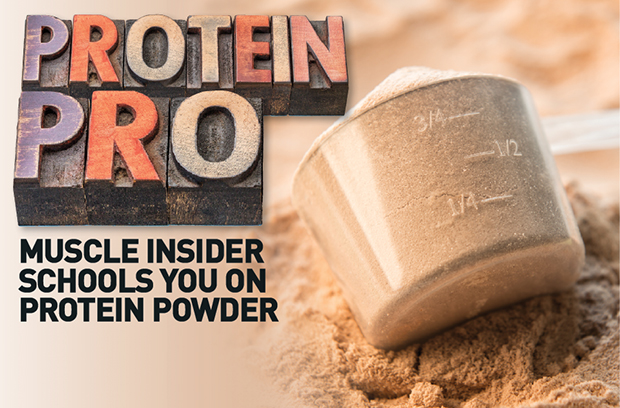Choosing The Right Protein Powder

The market of sports nutrition is booming, evidenced by the abundance of companies stocking store shelves. One of the longest running, most used products is protein powder. It’s no longer reserved for bodybuilders and competitive athletes; rather, most homes now have a protein supplement in the pantry. In fact, protein products have been estimated to account for 90 percent of the $6.7 billion sports nutrition market.
Beyond the growth in the number of companies providing supplements, protein powders have also grown in type, broadening to meet the various dietary needs of the public. Previously, individuals with allergies to dairy or eggs, or those who were vegan, had very limited options. Now, powders range from the tried and true whey to pea, soy, and even beef, enabling everyone to make use of the convenient supplement.
Because there are so many different varieties available, some may be unfamiliar to athletes. Knowing what’s out there, along with the benefits of each, will allow you to be an informed consumer and make the best choice for your health and physique goals.
Protein Purity
When browsing the shelves of a supplement store, the selection is overwhelming. You’ll also see proteins labelled as a concentrate, isolate, or hydrolysate, further confusing many consumers. These different options refer to the purity of the protein, based on the filtration systems used to remove non-protein nutrients.
Concentrates: Protein is extracted from whole foods using heat or enzymes. This method yields 60 to 80 percent protein.
Isolates: An additional filtering step is used after the protein is extracted. This filtration removes further fat and carbs, yielding 90 to 95 percent protein.
Hydrolysates: Further heating with acid and enzymes is applied to break amino acid bonds. This breakdown allows easier absorption of the product by the body, meaning it is easier on the digestive system and can be put to work faster. A downside of this is that it may result in more of an insulin response, at least with whey protein varieties. Hydrolysate proteins are the highest quality on the market, leading to a higher price tag.

Types of Protein Powders—The Options Are (Almost) Endless
At their root, protein powders are dehydrated forms of protein that can be mixed into liquids or added to food for consumption. Historically, a basic protein shake has been a bodybuilder’s post-workout staple meal, but the culture has dramatically evolved as the demand has skyrocketed. Now, you can find an option that works best for you and your lifestyle.
• Whey: Easily the most common type of protein powder available, whey can be traced back to the 1700s, when it was used as a medicinal tonic. Whey is found in milk products and is derived during the process of making cheese when milk is separated into curds and whey with the addition of enzymes. The curds go on to become cheese while the remaining liquid (whey) is pasteurized and turned into a powder.
Whey protein has many benefits. It’s a strong component to a meal plan for any physique goal; from muscle building to weight loss, it can aid your progress. Whey protein is easily digested and absorbed by the body, quickly getting to work to start the muscle protein synthesis process. Another bonus is that it’s a complete protein source that’s high in BCAAs. The one limitation of whey protein is its dairy component, making it off-limits for anyone who is lactose intolerant or has dairy allergies. Beyond that subset of people, you can’t go wrong with this protein supplement.
• Casein: Casein falls a close second behind whey for the most commonly used protein powder. Similarly, it’s a complete protein source derived from milk, ruling it out for those with dairy limitations. The biggest difference between casein and whey is in the digestive process. When casein interacts with stomach acid, a gel-like texture is created that slows down digestion, resulting in a slower release. This makes casein the perfect choice before bed or when you’re going to be going a long period of time without food.
• Egg: A lesser known variety, egg protein is a good choice because eggs are a complete protein and are safe for those who are lactose intolerant. Generally, it has the second highest source of leucine after whey, providing a boost for your immune system and potentially promoting the release of the human growth hormone.
One noted downside to this option is that it has been found to have less of an appetite-suppressive effect than whey and casein. If your current goal is weight loss, you’re likely living in a calorie deficit, and feeling satiated for longer is always a bonus.
• Pea: This is one of the newer options on the market, giving vegetarians, vegans, and those with dairy allergies a suitable supplement. Additionally, it’s free of gluten and soy. Peas, part of the legume family, have always been a prime source of protein for vegetarians. The soluble protein is extracted from yellow split peas, which are rich in amino acids, especially lysine. However, they’re low in cysteine, making it an incomplete protein source. This option is absorbed at a moderate rate—slightly slower than whey but faster than casein.
Due to the smaller pool of brands carrying this option, research on pea protein is rather limited at this point. It needs to be noted that the protein serving is less per scoop, coming in at around 15 grams per scoop—about 10 grams less than whey. This could add up to be a more expensive supplement if your usual serving size requires close to 25 grams of protein. However, if you’re dealing with digestive issues, it’s a good option to experiment with.
• Hemp: Derived from hemp seeds, hemp protein offers another plant-based option to the supplement market. Similar to other plant-based proteins, it’s easily digested, making it a good option for anyone who may experience bloating from other types of protein powder.
Hemp seeds are regarded as a superfood because of their antioxidant profile and high omega-3 and omega-6 fatty acids. While this can be a positive, it may also be a negative for some users. If you’re in a fat-loss phase, you likely don’t want to use a protein powder with a high fat content. Additionally, it comes in with a lower protein count per serving, approximately 15 grams per serving.
• Soy: Although soy protein powders aren’t commonly used in the bodybuilding world, many vegetarians use soy because it’s been available for over 80 years. Produced soybean meal that has been dehulled
and defatted is processed into soy flour, concentrates, and isolates.
Soy has received a lot of negative attention for its “femininizing” potential. The isoflavones—organic compounds present in soy—have been found to interact with hormone levels, potentially reducing testosterone levels in males. Researchers have deemed the occasional use of a soy protein supplement safe, but still advise against high intake levels of soy products, especially in males. If soy protein is of interest to you, you can opt for a concentrate version that has a lower amount of isoflavones due to the additional processing methods.
• Beef: The new kid on the block, beef protein offers a new avenue for supplement users—an animal-based protein that is dairy free and rich in amino acids. After boiling down beef, the fat and carbohydrate content is removed from the liquid, allowing the remaining aminos to be dried to produce the powder.
From a digestion standpoint, it’s similar to that of egg protein, which digests slower than whey products. However, because beef generally is harder
to digest, consumers may experience issues when first switching to a beef protein from their usual supplement. To alleviate this potential discomfort, slowly integrating the new product into your routine is advised.
Another factor to keep in mind with this protein variety is the flavour. Beef is inherently a savoury food, and many users report the protein powder to be much the same, often described as salty, chocolately, or even burnt tasting. For these reasons, it likely won’t be a good mix with any fruit-flavoured supplements.

Protein 101—The Facts
Switch It Up
In much the same way you should consume a variety of whole foods, rotating through protein powder supplements can be beneficial too. Regular long-term use of the same protein powder could lead to digestive irritation or even an intolerance. If you’re one of the majority of supplement users who stick primarily to whey, next time you hit the bottom of your tub and are heading to the store, consider buying a different type and using that for about four to six weeks. The change can be good for your overall gut health.
Complete vs. Incomplete
Often you’ll see protein sources referred to as being complete or incomplete, and protein powders are no different, but what does it mean? Complete options include all the amino acids in a high enough dosage to meet recommended levels. On the other hand, incomplete proteins either are lacking an amino acid or are too low in it to be considered a complete source. Obviously, complete proteins are ideal, but if you eat a well-balanced diet rich with a variety of whole foods, you’re likely making up the difference of any missing or lacking aminos in your supplement of choice. For this reason, it’s important to ensure you’re not relying heavily on powders as your main protein intake; rather, include different food sources such as meat, dairy, eggs, and legumes throughout the week.

Smart Shopping
When shopping for a protein powder, be sure to check the nutrition facts table to make sure it fits your nutrient goals. Not all brands are created equally, and you want to get the best quality for your money. To help, here are some general guidelines to use. Based on one scoop (35 grams), a beneficial nutrient profile is as follows:
• Approximately 25 grams of protein
• Less than 5 grams of carbs
• Less than 3 grams of fat
• Around 150 calories
Protein/Amino Spiking
Recently, some negative press has hit the protein powder market in the way of nitrogen spiking. As a supplement user, you should be aware of this tactic as it may be hurting your progress or your wallet.
Nitrogen spiking (or amino spiking, as it’s often known) allows supplement companies to include less protein in their products without being detected. When products are being tested for protein content, the nitrogen is measured as every amino acid contains nitrogen. Although amino acids are the building blocks of protein, they don’t carry the same benefit as true protein, but they’re a cheaper addition for the company. For a lower cost, adding ingredients such as glycine can allow the label to list 25 grams of protein per serving, although 5 grams of that may actually just be glycine, leaving you with 20 grams of actual protein.
An additional problem with spiking is that some amino acids aren’t utilized as protein building blocks. In this case, if a company is spiking its product with taurine or something similar, you’re getting an amino acid accounting for some of your protein intake that doesn’t even play a role in muscle protein synthesis. Taking the time to read the ingredient list of your selected protein powder can help you avoid buying an under-dosed product.
The Final Scoop on Protein
Supplementing with protein powder is a convenient, cost-effective way to help meet your macronutrient needs throughout the day. Regardless of any allergies, intolerances, or dietary choices, there is a product for you. Experiment with different types and brands to find your favourite, but be sure to take a look at the label information to get the best bang for your buck … and your muscles.

